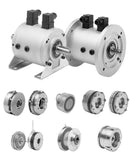Description
MWM ELECTRO MAGNETIC BRAKES, CLUTCHES & TOOTH-TYPE COUPLING CATALOGUE
Our many years of experience in this field has permitted us to obtain considerable
results, both regarding standard constructions and the applications that have been
specially designed by our Engineering Dept. for solving particular problems and
satisfying complex requirements.
INTRODUCTION
A distinction is made between the friction-plate type and meshing- tooth type coupling.
Electromagnetically controlled clutches can couple two rotating mechanical kinematic motion devices with different relative speeds (dynamic coupling).
In the case of the tooth-type coupling, the relative motion has to be kept to a minimum.
In all those applications with disk-type clutches and brakes, where excessive dynamic work or high operating frequencies are involved, it is recommended to use lubrication to rapidly eliminate any generated heat. If unexpected electrical power loss is possible, the thrust-spring type of brake, clutch or coupling is recommended, either in the
dry or lubricated version. The dry-operating, zero-play, thrust-spring brakes are very suitable for precision positioning, particularly with motor-actuated robot arms and circulating-ball screws for translational axial movement on CNC tool machinery.
To assure connection at a precise fixed point between two rotating parts, a tooth-type, phase coupling unit must be used.
SELECTION
In any application involving a brake, clutch or coupling unit, the
following important factors must be considered:
1. Type of machine
2. If the application is enclosed, with or without lubrication.
3. Type of controls available, according to the type of machine
or mechanical action.
4. Available space.
5. Overall maximum power to be transmitted.
6. Number of work phases.
When all these data are obtained, the right type of brake, clutch
or coupling unit can be selected. Then, proceeding with the size
calculation, the following technical data have to be obtained:
– Type of motor
– Motor power in kW
– R.P.M. of the brake, clutch or coupling unit.
– Regular interventions per hour (or maximum interventions per
minute) and degree of required precision.
– Moment of inertia J
– Acceleration or braking times


